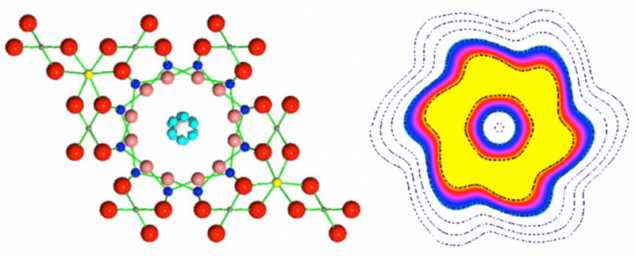Opened a new state of water molecules
 Bashny.Net
Bashny.Net
Neutron diffraction and computer modeling revealed the unique and unexpected behavior of water molecules under extreme confinement.
Researchers from the National laboratory in oak ridge in conjunction with the laboratory Rutherford-Appleton conducted an experiment to find out what happens to water when it is inside the minerals. Thus they wanted to understand what state takes the fluid in the microcracks in rocks, soil, and in the course of diffusion through the cell membrane.

During the experiment, water was placed in a hexagonal ultra-small channels in the mineral beryl. The diameter of these channels is only 5 angstroms, i.e. 10-10 meter (individual atoms, typically about 1 Angstrom in diameter). Exposing water molecules in the tunneling process — space in these containers — the researchers found that the particles demonstrate quite strange behaviour, overcoming the potential barrier and from the quantum motion. Such as H2O have been observed by scientists for the first time and did not correspond to the typical forms of the substance.
Previously it was thought that such a thing exists only in quantum mechanics. "In this case, the atoms of oxygen and hydrogen are "delocalisable" and, therefore, simultaneously present in six symmetrical positions of the channel," said the study's lead author Alexander Kolesnikov.

Water rings. One molecule of water may be limited within the channel of beryl hexagonal shape (left). Light blue spheres show the position of one hydrogen atom in the water molecule, as it occurs simultaneously in six symmetrical positions of the channel. Tunneling between these orientations means that the hydrogen atom is not in the same position, and "smeared" in the form of a ring. Right image in the spatial scale shows the electron density distribution of hydrogen, from blue (low) to yellow (highest).
The opening of this "quantum tunneling" States of water molecules in beryl is expected to help scientists to understand the thermodynamic properties of water in confined environments, such as carbon nanotubes, as well as in different geological conditions.
Researcher, Laboratory Rutherford-Appleton Lawrence Janowitz noted that the opening will cause debate in the biological, geological and physico-mathematical circles, as scientists try to explain the mechanism of this phenomenon and understand how it affects their sphere.
The researchers also reported that the average kinetic energy of protons of water obtained directly from the neutron experiment determines the speed of their movement at zero degrees Celsius and demonstrates 30% less than in liquid and solid form. published
P. S. And remember, only by changing their consumption — together we change the world! ©
Join us in Facebook , Vkontakte, Odnoklassniki
Source: geektimes.ru/post/274931/
Researchers from the National laboratory in oak ridge in conjunction with the laboratory Rutherford-Appleton conducted an experiment to find out what happens to water when it is inside the minerals. Thus they wanted to understand what state takes the fluid in the microcracks in rocks, soil, and in the course of diffusion through the cell membrane.

During the experiment, water was placed in a hexagonal ultra-small channels in the mineral beryl. The diameter of these channels is only 5 angstroms, i.e. 10-10 meter (individual atoms, typically about 1 Angstrom in diameter). Exposing water molecules in the tunneling process — space in these containers — the researchers found that the particles demonstrate quite strange behaviour, overcoming the potential barrier and from the quantum motion. Such as H2O have been observed by scientists for the first time and did not correspond to the typical forms of the substance.
Previously it was thought that such a thing exists only in quantum mechanics. "In this case, the atoms of oxygen and hydrogen are "delocalisable" and, therefore, simultaneously present in six symmetrical positions of the channel," said the study's lead author Alexander Kolesnikov.

Water rings. One molecule of water may be limited within the channel of beryl hexagonal shape (left). Light blue spheres show the position of one hydrogen atom in the water molecule, as it occurs simultaneously in six symmetrical positions of the channel. Tunneling between these orientations means that the hydrogen atom is not in the same position, and "smeared" in the form of a ring. Right image in the spatial scale shows the electron density distribution of hydrogen, from blue (low) to yellow (highest).
The opening of this "quantum tunneling" States of water molecules in beryl is expected to help scientists to understand the thermodynamic properties of water in confined environments, such as carbon nanotubes, as well as in different geological conditions.
Researcher, Laboratory Rutherford-Appleton Lawrence Janowitz noted that the opening will cause debate in the biological, geological and physico-mathematical circles, as scientists try to explain the mechanism of this phenomenon and understand how it affects their sphere.
The researchers also reported that the average kinetic energy of protons of water obtained directly from the neutron experiment determines the speed of their movement at zero degrees Celsius and demonstrates 30% less than in liquid and solid form. published
P. S. And remember, only by changing their consumption — together we change the world! ©
Join us in Facebook , Vkontakte, Odnoklassniki
Source: geektimes.ru/post/274931/
Tags
See also
What is sustainable development in the modern world
Opened new optoelectronic properties of perovskites
Stars do not give a molecule splits
In China, staged a show for the opening of a new shopping center
The opening of the new building "Centre Georges Pompidou"
The opening of the new building of the Museum of the Tula weapon
10 curious and unexpected space discoveries
Batteries can be made from wood
The ultra-fast heating up to the temperature of the Sun

















